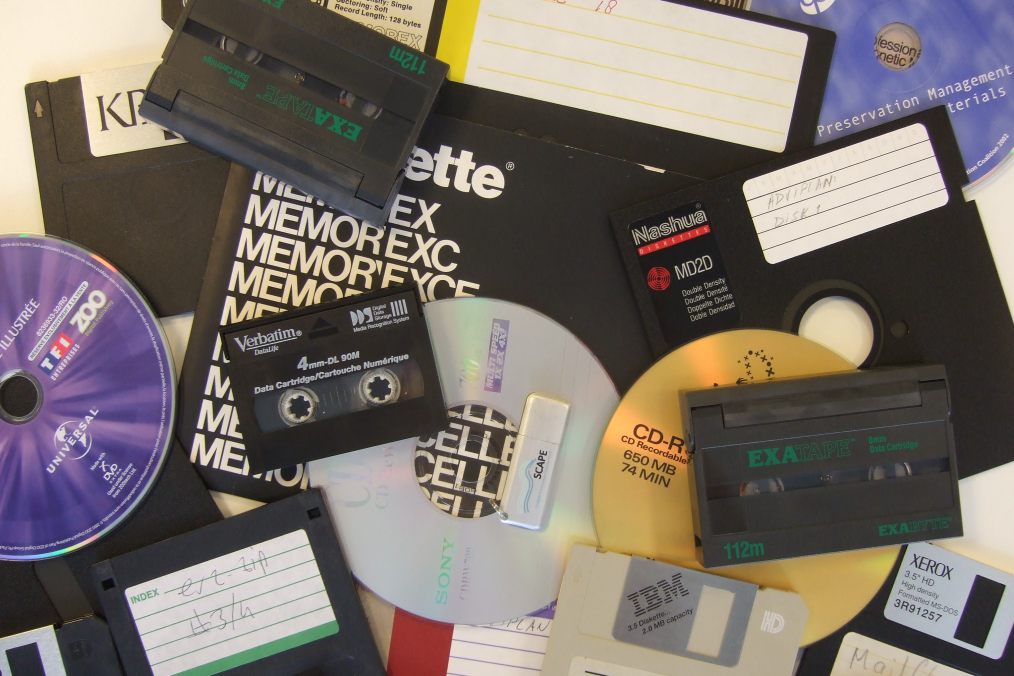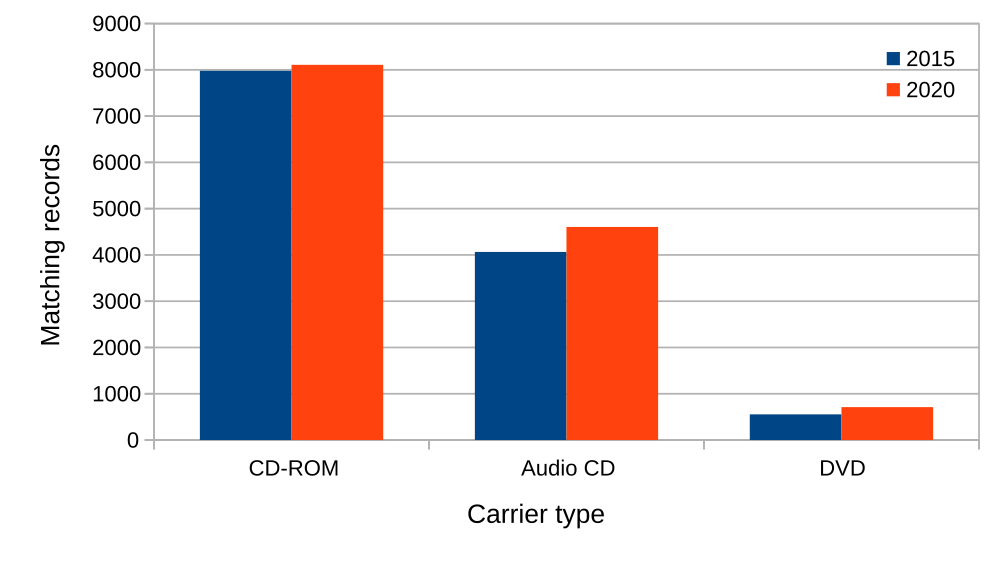Offline digital data carriers in the KB deposit collection

Following earlier work on the preservation of optical media and data tapes, I recently got a request to make an inventory of offline digital data carriers in the KB’s deposit collection. The goal was to obtain approximate figures on the various carrier types in the collection. This was partially prompted by a project on at-risk digital heritage on physical carriers by the Dutch Digital Heritage Network (NDE) that the KB is participating in. This blog post presents the results.
Data carriers in the KB catalogue
The KB catalogue is the primary source of information about carriers in our collection. It is fully searchable using the SRU protocol.
Carrier type codes not based on controlled vocabulary
The main piece of information to go by here is the value of the Dublin Core extent field1. However, in our catalogue the values of this field are not set from a controlled vocabulary, which means that one particular carrier type can be represented by different values. For example, here are some variations I found for CD-ROMs:
- cdrom
- cd-rom
- 1 cd-rom
- 2 cd-roms
For 5.25” floppy disks I came across:
- 1 diskette 5.25”
- 1 floppydisk 5.25”
- 1 floppydisk 5.25” in doos
This lack of consistency makes searching for specific carrier types rather difficult, and as a result most of the queries I used for this inventory are the result of trial and error.
Catalogue record can represent multiple carriers
In the examples above you may have noticed how in some cases the value represents multiple carriers (e.g. “2 cd-roms”). This is because our catalogue provides access at the level of publications, but not at the level of individual carriers that are part of a publication! A typical example to illustrate this, is a physical book with 2 supplemental CD-ROMs. In this case, the catalogue record represents the whole publication, and the extent field will have a value like “2 cd-roms”. As a result, the catalogue cannot be readily used to get precise figures on carrier types. In most cases the number of carriers for a specific carrier type will be considerably greater than the number of matching records, since an individual record (publication) may include multiple carriers. This is not really a problem for the current exercise, as its objective is limited to getting approximate figures only.
Results
I summarised the results in the table below. Here I made a subdivision between optical, magnetic and electronic carrier types. The table contains 4 columns:
-
Carrier type: the types listed here largely follow those proposed for an upcoming survey that will be launched as part of the NDE project on at-risk digital heritage on physical carriers (with some additions).
-
Category: this indicates the carrier type category (optical, magnetic or electronic).
-
Query: this is the SRU query I used to estimate the number of catalogue records for this carrier type. Follow the underlying hyperlinks to run the query yourself. Note that this field is empty for carrier types that -to the best of our knowledge- are not present in our deposit collection.
-
Matching records: this is the number of matching records in the catalogue. As explained in the previous section, this does not necessarily reflect the actual number of carriers, which may well be greater by a factor 2 (or even more).
| Carrier type | Category | Query | Matching records |
|---|---|---|---|
| CD-ROM | Optical | extent any “cdrom* cd-rom*” | 8109 |
| DVD | Optical | extent any “dvd*” | 711 |
| Blu-Ray | Optical | extent any “bluray* blu-ray*” | 4 |
| Audio CD | Optical | type any “geluidsdrager” and extent any “cd* compact” | 4605 |
| CD-i | Optical | extent any “cdi* cd-i*” | 44 |
| Optical carrier, unspecified | Optical | extent any “optisch* schijf” | 23 |
| Tape, unspecified | Magnetic | extent any “tape*” | 2 |
| Compact cassette, data (datassette) | Magnetic | extent any “cassetteband*” | 6 |
| Floppy disk, 8” | Magnetic | - | 0 |
| Floppy disk, 5.25” | Magnetic | extent any “flop* diskette*” and extent any “5.25* 5,25*” | 184 |
| Floppy disk, 3.5” | Magnetic | extent any “flop* diskette*” and extent any “3.5* 3,5*” | 1194 |
| Floppy disk, unspecified | Magnetic | extent any “flop* diskette*” not extent any “5.25* 3.5*” | 822 |
| Zip Disk | Magnetic | extent any “zipdis* zip-dis*” | 0 |
| Hard disk | Magnetic | extent any “hard*” and extent any “schijf schijv* disk*” | 2 |
| Compact Flash card | Electronic | - | 0 |
| Sony Memory stick | Electronic | - | 0 |
| SD card | Electronic | - | 0 |
| USB thumb drive | Electronic | extent any “usb*” | 44 |
| Solid-State drive | Electronic | - | 0 |
In the following sections I will highlight some of the most interesting observations that can be made from the table.
Optical carriers
Unsurprisingly, optical carriers make up the majority of offline digital carriers in the KB deposit collection. An effort to preserve the contents of these carriers using the Iromlab software is currently ongoing, but this does not cover Blu-Ray discs. At the current numbers we could probably just image them manually.
Development of optical carriers since 2015
Since I had already queried the catalogue for optical carriers as part of an investigation I did in 2015, I also compared the current figures against those in 2015. The following figure shows the result for the most prevalent optical carrier types:

And here in table form:
| Carrier type | Matching records (2015) | Matching records (2020) | Increase |
|---|---|---|---|
| CD-ROM | 7980 | 8109 | 129 |
| Audio CD | 4065 | 4605 | 540 |
| DVD | 554 | 711 | 157 |
The increase of the number of DVD records (an 28% increase) is particularly noteworthy. In absolute terms the number of audio CD records has increased even more. The growth of the CD-ROM collection has clearly levelled off at an increase of only 129 records over 5 years.
Magnetic carriers
In the magnetic carriers category the number of publications with floppy disks is noteworthy. Assuming each of these publications contains between 1 and 2 disks on average, the total number of floppy disks would be in the range 2200 - 4400. The majority of these are 3.5” disks, but for about 38% the exact type cannot be established from the catalogue alone.
An interesting curiosity is a handful of compact cassettes with software for the ZX Spectrum home computer.
We also appear to have 2 tapes of unknown format, and 2 hard disks. These need further investigation.
Electronic carriers
Here we have 44 USB thumb drives, and we should probably consider imaging them sooner rather than later. We don’t appear to have any of the other carrier types in this category.
Final remarks
Despite the obvious limitations of the methodology, the above inventory provides a tentative overview of offline digital carriers in the KB deposit collection that will probably be useful for preservation planning. It might also guide future efforts at saving information on “at risk” carriers.
-
Oddly, this field is meant to record “The size or duration of the resource” as per the Dublin Core specification. ↩
-
optical-media
- Identification of physical storage media and devices with Python and the Windows API
- Introducing Isolyzer 1.4
- Offline digital data carriers in the KB deposit collection
- A simple workflow tool for imaging optical media using readom and ddrescue
- Resurrecting the first Dutch web index: NL-menu revisited
- Update on Isolyzer: UDF, HFS+ and more!
- Image and Rip Optical Media Like A Boss!
- Imaging CD-Extra / Blue Book discs
- Detecting broken ISO images: introducing Isolyzer
- Breaking WAVEs (and some FLACs too)
- Preserving optical media from the command-line
-
tapes


Comments